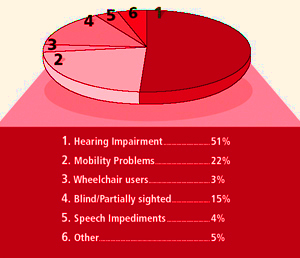Property Owners and Employers’ Responsibilities
The Health and Safety at Work Act 1974 and related regulations

Health and safety legislation requires employers and persons concerned with premises to undertake risk assessments and produce a health and safety policy. The risk assessment should list any risks to staff or others, including students and users of services, and what control measures the employer will take to reduce those risks. Control measures may include:
- Procedures for lifting people and equipment
- Guidance on visits to students in their homes
- Appropriate training and guidance for staff
- Keeping passageways and means of access and egress clear and hazard-free
- Minimising the risk posed by any machinery or hazardous substances (including any stored medicines)
- Procedures for the safe disposal of waste and safe practices in first aid
- Adequate procedures for monitoring and auditing to ensure that health and safety practices are operating properly.
The Disability Discrimination Act 1995 does require responsible bodies not to place employees or others at inappropriate risk. However, in many cases, changes to procedures, the provision of training or the purchasing of equipment may mitigate any risks that arise in relation to disabled people and students. The risk assessment process carried out to comply with health and safety legislation may provide an opportunity to consider adjustments required by the Disability Discrimination Act.
What is Risk Assessment?
The HSE’s publication Fire-Safety — An employer’s guide, details the “risk assessment” procedure to be used, in Parts 1 and 2 of that guide. Fire risk assessment is a five-fold process:
STEP 1
- Identify Fire Hazards
STEP 2
- Identify People at Risk in Fire
STEP 3
- Evaluate the risk including:-
- Is Means of Escape adequate?
- Is Employee Training adequate?
- Is Maintenance and Testing adequate?
- Carry Out Improvements Necessary
STEP 4
- Record Findings and Action
STEP 5
- Keep Assessment under Review
There are no hard and fast rules as to how the assessment should be carried out. The important thing is that it should be both practical and systematic to ensure that the whole of the workplace is examined — every room or area, particularly any not often in use.
The Fire Precaution Act 1971 and related regulations
Legislation exists to prevent the risk of fire and the risk of injury in fire. In particular there are laws to ensure adequate warning in the case of fire and the safe egress of people from buildings to a place of safety in case of fire. Responsible bodies must ensure that they do not breach fire regulations in their relationship with disabled people. In many cases reasonable anticipatory adjustments can be made which will ensure that warning of fire and access and egress routes can be provided for disabled people. For example:
- Fire refuges on stairwells for those with mobility difficulties in case of fire
- Flashing light fire alarms or vibrating pagers for deaf users of buildings
- Clearly visible and simple to understand signage to indicate escape routes and exits
- Increased numbers of exits or wider doors to ensure egress from a large meeting room
- Emergency evacuation procedures.
System Design Guidance
Always refer to the requirements of the Building Regulations 1991, and the Building Regulations (Amendment) 1998, Part M (Access and facilities for disabled people) so as to practice good building design.
All business must now provide facilities for disabled persons and this legal obligation extends to the fire alarm system.
There are numerous methods of compliance with the Disability Discrimination Act including fixed equipment such as visual alarm indicators, portable equipment such as vibrating pagers and pillows or instructing staff to ensure the safety of disabled persons using the premises.
Failure to provide fire alarm protection for disabled persons in any business premises is a breach of the law.
All automatic door opening installations must comply to BS7036.
On any door opening installation please be aware finger guards may be required either roller blind type or finger guard (plastic).
Alarm Systems
A fire alarm should be visible as well as audible to all users, particularly hearing or visually impaired people.
An emergency assistance alarm provided in a lavatory for disabled people should be designed so that it is not confused visually and audibly with a fire alarm.
An emergency assistance pull cord should be sited so that it can be operated from the WC and from an adjacent floor area.
The reset control for the emergency assistance alarm should be clearly marked as such and reachable from both a wheelchair and the WC.
In changing areas and showers without toilets the emergency assistance pull cord should be reachable from the shower or from the floor.
A fire alarm should emit a visual and audible signal to warn occupants with hearing or visual impairments.Individual under-pillow vibrating alerts that plug into the fire alarm system may also be appropriate for people with hearing impairment, particularly to wake sleepers in emergency.
An emergency assistance alarm should be provided in an accessible bedroom and activated by a pull cord sited so that it can be operated both from the bed and from an adjacent floor area.
The pull cord, coloured red, should be provided with two red bangles of 50 mm diameter, one set at a height between 800 mm and 1000 mm and the other set at 100 mm above floor level.
Visual and audible feedback should be provided to indicate that the emergency assistance system has been activated when the pull cord has been operated. The signal of the emergency alarm should not be confused visually and audibly with the fire alarm.
The emergency assistance alarm indicator outside a bedroom should be located so that it is easily seen and heard by those able to give assistance.
An additional alarm indicator may also be sited remotely.
The reset control for the emergency assistance alarm should be reachable from both a wheelchair and the bed.
Provision of accessible bedrooms
An accessible bedroom should cater for as wide a range of disabilities as possible.
The provision of accessible bedrooms should reflect the numbers of disabled people likely to use the resources and activities available within a building. However, a minimum of one accessible bedroom should be provided for every 20 standard bedrooms, or part thereof.
Accessible bedrooms should be located on accessible routes that are direct and obstructionfree. Suitable means of escape should be provided in accordance with BS 5588-8.
Ticket sales and information points
Ticket sales and information points that are located in noisy environments or that have security screens should have at least one position fitted with a hearing enhancement (induction loop) system to assist hearing-aid users. Where more than one position with a hearing enhancement system is provided, these positions should be spaced apart sufficiently so that there is no spillover between positions. Furthermore, one of the positions fitted with an induction loop system should also be suitable for wheelchair users.
Loop induction system
This system is subject to a magnetic field test prior to completion to all works on site in accordance with BS7594.
Cabling for the Loop Induction should be a solid core single strand PVC sheath cable a minimum 1mm square.
For further information ring our Petersfield Service Centre on 0845 884 7000.
If cabling is fitted in the floor screed it must be encased in PVC conduit.
If flat loop tape is used ensure protective Gappa Tape is used to protect the loop tape.
We would strongly suggest that a test loop be installed to ensure the system works correctly prior to any order being accepted. For further information contact either our Petersfield Service Centre or your local Sales Engineer.
Counter Audibility Systems
Relatively inconspicuous sound systems which overcome the problem of communicating through a glass screen. The system comprises two of any type(s) of loudspeaker, two of any microphone(s) and a stereo amplifier box with power supply. Alternatively a combined microphone/ loudspeaker console can be supplied for the clerk’s position. An induction loop system is incorporated allowing hearing aid wearers to hold a conversation with a clerk.
Types of Disability
A typical perception of a disabled person is that they are wheelchair users, however as the diagram shows this is a huge misconception.

This information can help the responsible person at all buildings ascertain the likely needs of the disabled and then plan the requisite products and services necessary to meet these needs.
Other Considerations
One of the major impacts that the DDA had relates to fire alarm systems. The British Standard applicable to fire alarm systems is BS5839, this standard has always stated “additional means of giving warning to people with impaired hearing might be appropriate”, clearly the Equality Act (incorporating DDA) takes this proposal a lot further by now making it law.
Now every fire alarm system design must take into account the needs of the disabled and consider points such as whether such a person might visit, work in and or sleep in the premises. Quite obviously schools, colleges, universities and hotels come under this category, and a number of specific products and/or services are now required to ensure compliance with the Act.
Who is affected by the Equality Act?
The questions below gives an excellent guide as to who is affected:
- Does your organisation provide goods or services to the general public?
- Do members of the general public visit your premises?
- Does your organisation conduct interviews on your premises?
- Do you carry out training/instruction in your premises?
- Does your organisation have a website?
- Are you a landlord?
If you have answered YES to any of the above questions you should contact Channel Safety Systems on Telephone: 0845 884 7000 Fax: 0845 884 6000 Email: sales@channelsafety.co.uk
| USEFUL CONTACTS AND NUMBERS | ||
| Disabled Resource CentreDRC Helpline,FREEPOST,MID 02164,Stratford upon AvonCV37 9BRTelephone: 08457 622 633Textphone: 08457 622 644Fax: 08457 778 878Email: enquiry@drc.org.ukWebsite: www.drc.org.uk | ||
N.B. Sleeping accommodation will satisfy the requirement M1 only if all bedrooms have a visual fire alarm signal and some have a vibrating pillow facility. Both audible and visual indication must be given in the bedrooms, communal toilets and bathrooms/shower rooms.
